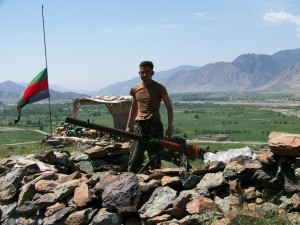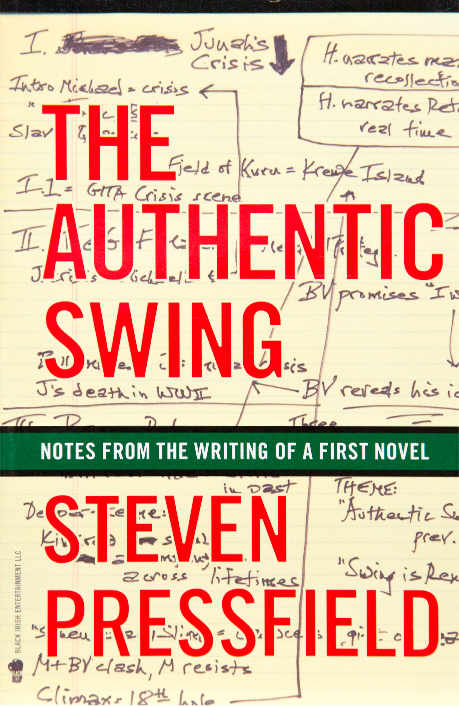Guest Blog by Andrew Lubin: Let the Afghan Army Fight

[Again, we’re pleased to have this fresh post from independent correspondent Andrew Lubin, who has just returned from six weeks in Afghanistan, where he was embedded with Army and Marine troops and spent time with their Afghan National Army counterparts. Here’s Part Two of Prof. Lubin’s report.]
Training the Afghans how to shoot and move is the easy part. A typical Afghan soldier can probably beat an American tri-athlete up a steep hill; add in the flak, Kevlar and other equipment our troops carry, and the Afghans look back at us in amusement.

An ANA soldier mans his post after a firefight near Camp Joyce; the Marines and ANA fought off an attack the prior night
What’s not so amusing is the drug use, absurdly low pay, desertion, casual corruption, and problems caused in Kabul, much of which affects the ANA’s ability to fight.
The pay issue was finally addressed last week when Lt. Gen. William B. Caldwell IV, who now oversees the training of all Afghans, increased the pay for both the Army and the Police. The salary for a basic soldier is now $165/month, for a sergeant $210. While this is still far below the $250 or so that the Taliban pays its fighters, Afghan patriotism is such that enlistments boomed within the next days. One can imagine the results if we simply paid these volunteers close to the same.
The issue facing Gen. McChrystal and Gen. Caldwell is not just one of increasing the size of the Afghan Army, but rather having an efficient Afghan Army. If the war is to be “Afghanized,” then the ANA needs to be an effective army and not just a job-training program where the troop strength numbers look good on paper but don’t add up in the field. The question is not only how to properly train the young Afghans who enlist so enthusiastically, but how to better utilize the Afghan army as it is.
There are simple solutions here, except both are studiously being ignored in ISAF Headquarters, which is actively trying to over-complicate the ANA in their zeal to turn them into mini-American soldiers:
1 – Instead of forming more kandaks (Afghan Army battalions), increase the size of the existing ones. The ANA is short of good officers and senior enlisted; forming more kandaks will dilute these numbers even further. Inexperienced or incompetent officers and senior enlisted are bad for discipline, bad for morale, and they sap the Afghans’ ability to fight.
Increasing the kandaks from the current 670 to, say, 900 will enable the good officers and senior enlisted to retain control of their troops while incorporating the new and inexperienced troops into their kandaks.
2 – Push the ANA into the fight without further delay. It’s going to take years to get them spun up to Tier One units; so get their headquarters units co-located with their American mentors. Get the Afghans involved in the planning, in the logistics, and in their own training. Push them into the fighting ASAP; their “good enough” is in fact good enough. Plus they’re respected by the Afghan people; the more you can get them in front of the locals, the more you’ve Afghanized the war.
There is already a program in place, instituted by the 3rd Marine Division, whose officers and men have been working with the ANA’s 201st Corps for the past four years. It’s called “Muscular Mentoring” and it’s extremely effective. Each Marine is paired with his 201st Corps counterpart, with the Marine colonel mentoring the 201st Corps CG. From going into the field together to planning missions to sharing chai and conferring about leadership, the Marines and Afghans serve as one.
The program works; in Kapisa Province’s Tagab River Valley, the ANA built their own FOB; their troopers maintain security in the southern part of the valley. Giving the Afghans their own battlespace builds both their expertise and effectiveness, as well as promoting their reputation amongst the locals.
This is a vivid contrast to the situation some 20 miles away in Mether Lam, where an American National Guard unit has no interaction with an 80-man ANA troop with whom they share a base. With an increase in IED attacks on the main road, it is disturbing that the Guardsmen have not approached the ANA for joint missions, but instead continue to patrol from the back of their MRAPS with minimal ANA input on intel, tactics, or strategy.
Last year I interviewed a group of young Afghan enlisted men. “Why’d you join up?” I asked. “My mother and father fought the Russians,” one soldier told me, “and my great-great grandfather fought the British, as did his grandfather. I hate the Pakistanis, and want to kill them all.” These young men don’t need to sit through an Army PowerPoint; if we could harness this sort of fighting spirit to some reasonable leadership, we won’t have to worry about withdrawing in July 2011; we can withdraw tomorrow.




I challenge Mr. Lubin on several points:
– As far as the debate whether to increase the size or the number of the kandaks, I believe he underestimates the challenges presented to Afghan officers and NCOs by accepting more troops. Either way, you only have a certain number of leaders who will necessarily have to absorb the demand placed on them by a greater number of subordinates. He recommends increasing the size of existing units by over 30%. There’s no way that such a move upholds the principle of maintaining reasonable span of control– which, for reference, military circles typically place at five. The Army is still following a plan whereby it will increase the line strength of its combat brigades, but it is on a long and deliberate trajectory that is years from culmination. One of the drivers of that trajectory is available officer and NCO leadership. You can make it a convoy or a clown car, but either way you have to have enough people step up to take the wheel. Lubin is astute in the observation that we’re presented with nothing but bad choices, but I dispute that either option is better than the other.
– Time spent training “in garrison” has a bit more value than Lubin gives it credit for. As Patton himself said: “If you can’t get them to salute when they’re supposed to salute and wear the clothes you tell them to wear, how are you going to get them to die for their country?”
Perhaps it’s easier to get an Afghan volunteer to die for his country than some of Patton’s conscripts, but how easy is it for us to ensure they don’t extort truck drivers at security checkpoints, raid villages for food or money, or commit atrocities in the face of resistance? I’m not sure if I’d be eager to walk a patrol with an Afghan soldier who has every intention of shooting the first Pakistani he sees. We can probably dispense with the PowerPoint, but we could at least start with Roger’s standing orders to his Rangers.
The best argument on this point is Lubin’s own observations regarding the National Guard. I worked with several NG units during my time with the 101st, with at best mixed results. The 278th CAV from Tennessee completely stopped patrolling in certain areas of their battlespace in 2005 after an Al Qaeda unit gave one of their platoons a black eye in a fire fight. Other patrols regularly took contact from IEDs within sight of the main gate of their FOB. Discipline and understanding of the battlespace within that unit was deplorable. Meanwhile, a group of UAV operators from the Minnesota National Guard served our unit with great effectiveness and professionalism. The difference was in training– the 278th CAV were on the typical NG training schedule and put the same amount of time and concentration as they normally would. They weren’t professional soldiers. If you’re not a professional, you know what that makes you. The UAV unit from MN spent over a year prior to their deployment receiving daily, concentrated instruction in the maintenance and deployment of their aircraft. They were better soldiers because they’d taken the time to do the classwork before the fieldwork. How much training did the NG unit Lubin observed get? What’s their leadership background? Are they really professional soldiers? I believe Lubin’s estimate of their performance is that their good enough ISN’T in fact good enough. The implications are clear.
Lubin greatly overestimates the value of “fighting spirit” and the ease with which it’s harnessed. Afghan stallions are some of the greatest war horses in the world, I’m sure. But each one has to be tamed at least enough to learn how to wear a saddle and a bit, otherwise watch out for the open barn door. That process takes time, and it certainly doesn’t happen overnight.
Leadership is the most difficult thing we practice in the military, and while we do it better than a lot of other organizations no one dares claim that we’ve perfected it. One thing we do know is that great leaders, even just good leaders, are like diamonds– they take time to make and even then they’re not always readily identifiable. It’s long, arduous work that makes them, but given their value and our failure to create them by any other means, we continue to follow the tried-and-true methods of history. There’s no short-cutting the process, so the best strategy for us and the Afghans is one of patience.
Mr. Gourley; I’m glad you wrote. You’ve raised some excellent points, and I appreciate the opportunity to clarify some of mine:
1 – Increasing the size of the kandaks vs. forming new ones. OK, perhaps a 30% increase is too much, but if you form a new kandak, from where do you get its leaders – by stripping your experienced officers and NCO’s from the existing kandaks? Now you’ve buggered the existing unit. No, it’s best to have an overworked good NCO, who can grab some younger enlisted and let them learn leadership under his tutelage. Remember, you’re not going to see this huge increase in ANA recruits tomorrow; perhaps we increase each kandak by 15-20%, training officers and NCO’s simultaneously. Then we’ve got an experienced cadre of leaders with which to form the new kandaks.
2 – There comes a point ‘in garrison’ where you’ve got to get outside the wire. The typical ANA can’t read or write, so extended garrison training won’t help him. But learning how to patrol, or in the case of an NCO, learning how to command a patrol, will help him more than watching a power point as it’s translated from droning English to droning Pashtu.
3 – There are both good and bad ANA, but overall, the problems with extorting bribes from truckers and locals are more common amongst the ANP than the ANA. At least the ANA aren’t shooing their Marine and Coalition trainers, as the ANP has done in the past few months. Plus the ANA (or at least the ones I’ve met) ‘want’ to fight, as opposed to being ‘paid’ to fight.
4 – The National Guard. Those Minnesota boys are good! I embedded with the Red Bulls in Iraq; some outstanding soldiers. My point, however, is that the NG unit I wrote about in my post (leaders were professional and several had previously deployed) had a very, very conventional mindset. They refused to think and act other than by-the-book. Lots of individual courage, but when you’re grossly undermanned, are taking casualties…and have 80 trained troops on the same base…why not use them? At least talk with them – and why not also have a chat with the 15 Marines also on base who are mentoring those same ANA? My point was not anti-national guard but rather that the ANA understand the locals better, and we need to involve the ANA at every opportunity.
5 – I’d prefer a fighting spirit. No one remembers what caliber, stance, or tactics you used or how much class-time you had learning them; they’ll only remember who lived and who didn’t.
6- Leadership. You and I can trade clichés for weeks (or we can just quote Leonidas and Dienekes in ‘Gates of Fire’!). But leaders are born as well as made, and frankly we don’t have the time to wait. Like Sheik Sattar in Ramadi, and countless young Marines and soldiers over the years, these young studs can only step forward when they’re on the battlefield – so put them there! Think Audie Murphy, enlisting at 16, w/first of many citations@ 17 or Pfc Hector Cafferata, (USMC, Korea, Medal of Honor @20). Now let’s give their Afghan equivalents an opportunity to step forward.
Mr. Lubin,
I still reject your points, and must voice that out of concern for how they might influence other readers on this blog. As with MAJ Gant, please consider this loyal opposition, except in this case it must remain opposition instead of changing to support. My disagreement with you is on this set of considerations though, and I doubt it would extend to other matters.
1- A unit must always train and operate according to the capabilities of its least-trained members. Any experienced combat vet will bemoan anecdotes demonstrating the principle of “the lowest common denominator”. Your standing leaders and NCOs will spend an inordinate amount of time wiping the noses of the ‘FNGs’. Again, according to your own observations, which would be better, half the Marine unit or doubling the size of the NG unit? Quality doesn’t always beat quantity, but it gets exponentially more results.
2- You’re correct about the threshold of diminishing returns when training inside the wire, but it is hardly met at the end of the eight-week training period that ANA troops now undergo. These are guys straight out of boot, in the US that’s hardly enough time to get them to know how to soldier and shoot, let alone the specifics of their combat specialties. There’s a gracious plenty that these troops can learn, let alone what needs to be done to get units organized and fighting as a team. Pushing them out of the wire and into the meat grinder is unfair.
3- I’m not concerned so much about whether the ANA want to fight as much as ‘who’ they want to fight. 99.999% of American soldiers are stand-up folks who want to help Afghanistan and Iraq. However, PFC Steven Green was our .001%, and look at the consequences. Are the ANA proportions as good? Is Karzai prepared to do that much damage control? If not, we need to identify and prepare good Platoon Sergeants.
4- We agree. I wasn’t slamming the guard as a whole either, but I wanted to make the point of what happens when you don’t hold people to a high enough standard. As you state, those Marines are four-and-five-time combat vets. It took that much to get them to figure out how to partner with indigenous forces well. That Marines are helping Georgian troops prepare for their upcoming mission there instead of Special Forces is a testament to just how far our conventional forces have come in working with international allies. But that’s the result of a long, sustained effort of training and practice. Within that lies an argument for the ANA getting “real experience”, but only after adequate preparation.
5- I’d prefer not to share a foxhole with someone who is equal parts dumber and braver than me. You’re dead wrong about combat memories. Everyone remembers MAJ Dick Winters’ assault on the Normandy artillery positions– the attack is still studied at West Point. Everyone remembers Custer, too. Both had great fighting spirits. Those who don’t study people who lose and how they restructured their tactics are doomed to repeat the mistakes of history. Another great tribal leader, Attila the Hun, was sorely beaten at Chalons. He quickly re-trained his forces to use different tactics and incorporated arms and armor similar to the Romans. His victory at Aquileia bears out the value of Proper Prior Planning and its Prevention of Poor Performance (we typically use a seventh ‘P’ in that phrase, but I’ll refrain for propriety’s sake). Certainly, more than one eager Hun got tired of the incessant drilling in these ‘new-fangled’ infantry tactics, but Attila maintained strict (albeit brutal) discipline. He knew all too well that people only remember who lives, and so took the class-time to ensure he’d be the last man standing.
6- I would use an anecdote or quote to illustrate a point, but you use “leaders are born, not made” to justifyone and do so incorrectly. Leaders are certainly born, and then they’re identified, selected, trained, and tested. There is no denying the possibility that we gutted the West Point classes of 1966 and 1967 of the best leaders they had simply because we rushed their tactical training. We can ill-afford to squander ANA officers and NCOs in a similar fashion. General Petraeus is a great and brilliant leader, and was probably born that way, but somewhere out there is a retired NCO who remembers the insecurities and mistakes of Lieutenant Petraeus. He was born, and then he was bred. If we don’t have the time to wait on the ANA then you are correct that we should leave tomorrow, because we rush to failure. As Chief Zazai on this website would argue, the coalition rushed to form an Afghan government because it placed a premium on making SOMETHING. What we made is poorly crafted, ill equipped and trained, and largely ineffectual. It does not have the capability to ensure domestic tranquility or establish justice. How effective will the ANA be at providing for the common defense if we put it on the same condensed timeline in the interest of pushing it out the door?
Audie Murphy won a battle and destroyed several tanks. It took the whole 3rd ID to smash through the Ardennes and destroy the German Army, and even then they had the help of a few other divisions. We cannot place all our eggs in the basket of a few heroes. If we could, we wouldn’t be surging 30,000 more troops there right now. Afghanistan needs an Army. Raising one to do so will simply take time. As Secretary Gates and even the President himself have already said, 18 months isn’t necessarily a ‘hard’ deadline. There’s no need to work ourselves into a tizzy to wrap this up neatly according to the calendar. As we’ve seen over and again in Afghanistan as well as Iraq, doing something quickly only means we’ll have to come back and fix it. As we backtrack over the mess we’ve made of the national leadership, we should be careful not to repeat the same procedural and organizational errors in the context of standing up an essential piece of Afghanistan’s future.
I am not sure the hatred of any nationality or people is what we should be betting our future on. Hatred is a fickle master. It is not intelligent, courageous or loyal. Blind hatred towards any nationality has been the cause of many wars. If we want this, and all war to continue, we should align ourselves with those who hate. Otherwise, I think we should align and recruit those who act with intelligent discernment.
Andrew Lubin, the ANA is partly following your advise.
44 ANA combat manouver battalions in the East and South are getting a 4th combat company (this is in addition to the HHC company and Combat Support company.)
In addition each ANA battalion is targeting a 117% assigned/authorized ratio. To reach the 117% assigned ratio, 7,500 ANA are being added to the rolls.
The ANA is also adding 4th combat manouver battalions to many ANA Corps. 9 have been added so far (a total of 8 brigades now have 4 combat manouver battalions, because 3-2-207 didn’t exist in 2009.)
In addition the ANA adds two new brigades to Helmand in 2010; and possibly one brigade to 207th ANA Corps in Farah (although 3rd Bde, 207th ANA might have been diverted to Helmand for 2010.)
Personally, I think ANA combat battalions could be increased even further in strength to more than 1000 each. This would mean more independently deployable companies and bluks (platoons), and more opportunities for junior leadership to develop. My preferred way to do this would be to increase the number of platoons and squads per company, and to facilitate opportunities for platoons and squads to operate independently.
Jim Gourley, a typical Indian army battalion has 900 authorized. What is wrong with 900 or 1000 sized battalions?
Lubin, I disagree with you about rushing training cycles. Basic Warrior Training Course [BWTC] has already been lowered from 16 weeks, to 12 weeks, to 10 weeks to 8 weeks. There is substantial value to longer training cycles, including the literacy training longer training cycles allow.
More important than basic warrior training course, however, is NCO and officer training. Both of these have been excessively compressed. A Lietenant now only gets 20 weeks of training. NCO specialized training–or SLC (I think this stands for Sergeants Leadership Course)–is only 6 weeks long. In my opinion the number of NCOs and officers being trained at any given time needs to to increased by a factor of 5 or 10. This would enable longer training cycles, greater literacy, and rapid officer/NCO expansion. If we Americans are not willing to provide the officer/NCO training through put; then put pressure on South Korea, Turkey, India to do it in our stead.
Like you, I am impressed with what 3rd Marine Division and the French are doing with ANA’s 201st Corps. However, 201st ANA Corps, 1st and 2nd Brigades, still isn’t as good as it could be. Why do you think this is? [3-201, the only heavy bde in the ANA, seems to be a success story.] Would you agree that 203 ANA Corps (which isn’t Marine mentored) is performing better than 201 ANA Corps? If so, why do you think this is?
Can I ask you what specific ANSF units you interacted with? Could you rate these units relative to each other?
Thanks again for all your information Lubin.
Great discussion. I’d like to offer several recommendations regarding the ANA:
1. Generate larger formations, especially infantry, not more formations. ANA do not have enough good leaders to go around to add numerous kandaks and brigades. A 800-900 man kandak can be lead/managed by a good command and staff structure with sound leaders. From the larger kandak, strong leaders will bubble to the top, there are your future commanders.
2. Take immediate action to improve existing ANA leaders—e.g. enlisted to officer accession program; advisors monitoring command screening and G.O. promotion processes; dramatic increase in NATO school quotas.
3. Commence core values campaign to instill and reduce corruption within the ANA. Make the ANA an example as the non-corrupt Afghan institution.
4. Beware of over-partnering.
Over-partnering leads to a “needy” army and will stunt ANA growth.
Partnering is not a substitute for advising.
5. Drop the term “battlespace owner,” it sends the message to the ANA that this is a coalition problem.
6. Develop a construct to transition battlespace to the ANA now.
Consider the 2007 MNF-W memorandum as a model. This will prompt action and initiative on the part of ANA commanders.
Evaluate ANA commanders based on their performance in their own battlespace. The Capability Milestones rating alone is an inadequate measure of success.
7. The ANA must be required to execute more COIN campaigns…now!
Engage/Develop/Secure instead of Clear/Hold/Build
ANAmust pick the right valleys and endeavor to transform them with population participation. The purpose of the campaign must be to establish governance and to increase development.
The people prefer a mediocre ANA solution to a perfect coalition one.
Advisors help achieve unity of effort among external resources, NGOs, US PRTs, etc.
ANA campaigns set condition for the NSP and CDCs to flourish.
We must enable the population to be part of a solution to achieve a sustainable level of prosperity and security worth their fighting for.
In the end, ANA must “own”the battlespace.
Semper fi, Jeff Haynes, Col USMC, retired, Senior Advisor to the 201st Corps, 2008.
Vice President for Operations, Glevum Assoc
COL Haynes,
Enjoyed reading your post. A few questions:
– You said “generate larger formations… not larger formations”. Could you clarify the type-o? Thanks.
– By increasing ANA school quotas do you not run the risk of cutting corners and reducing quality in lieu of quantity? Or do you simply mean that we should create more or larger school houses?
– My thought exactly with regard to the need for maintaining the “in garrison” training time. Given your experience with this I’d like to ask, is the training model we’re using aimed at instructing along Afghan lines of value or our own? What is the relative effectiveness?
– Agreed. Again, an experience based question. What is the relative degree of mission failure we assume by sending them out with less help, and has it been acceptable? Do the Afghans feel that we only let them play at the shallow end of the sandbox and save the important missions for “the big kids?”
– Agree with your assessment of “capability milestones” as a barometer for success. In Iraq, however, we used the evaluations of partnered US Commanders as the indicator. It involved writing and reading longer reports, but we had to get out of the “red-amber-green” status based on supply and graduation rates. I’m not familiar with the MNF-W memo. Can you direct me to a link for it?
– On points 5 and 7, I have a few concerns. If I’m to focus on employing these solutions do I really have to spend the extra time it takes to learn a new vocabulary to do so? Clear-Hold-Build is a doctrine we haven’t had time to solidify in the minds of our mid-level leaders yet. I’m not familiar with Engage-Develop-Secure as a model. How many others would see it as a foreign concept? The same goes for “battlespace owner”. In my mind, someone has to be in charge. That goes to the person with the title. Whether you call him BSO, Head Master For Infantry Combat, or Emir of the valley, does a commander by any other name not stink of a “coalition problem?”
Any material you can provide on the E-D-S model would be appreciated. At first glance (without context), I would believe it to be somewhat similar to failed methods prior to 3-24. In effect, find the contractors, build the school/clinic, constantly worry that it will be blown up by insurgents still operating in your area. If security is placed last in the order of movement, I challenge just how much development can be accomplished without a two-steps-forward-one-step-back progression. I don’t have any statistics, but plenty of first-hand anecdotes.
Thanks for your contribution.
With regard to the above assertion about the size of Indian units, I again refer to span of control theory. If the Indians have larger units, they should necessarily have more leaders. At the end of the day, there’s only so much effectiveness a leader has the more people he has to lead. He only has two eyes, two arms, and one radio. The more people placing a demand on him for information, guidance and orders the thinner he’s spread. At a point, those subordinates have to act with greater self-confidence and independence until they reach a threshold of being totally independent commanders, which creates de facto distinct and separate units. In effect, the units partition themselves. The process is much more messy than that though, especially if it’s out in the field with bullets flying. The theory wasn’t developed to dominate human behavior, it was derived from observations of it. Again, this isn’t meant to question the ability of Afghans to fight, rather their ability to fight as an Army.
Yes, a typo, it should read generate larger formations, not more formations. Make the kandaks 800 plus. Reduces the leadership bill.
Get more ANA personnel to professional military schools: US Army, Marines, UK, etc.
More later.
Thanks,
JMH
I would offer that when the security/national interests of a dominant global power are held hostage to its ability to penetrate a tribal, some would say primitive, mindset it represents a systemic failure of domestic governance and foreign policy. Furthermore, policy that has as a key component the ability of very young men and women to be warriors one instant, social workers the next, anthropologists the next, entrepreneurs the next, civil then administrators, diplomats, etc., is the product of disordered minds most of whom will never have to execute these requirements under whatever ROE happens to be in vogue.